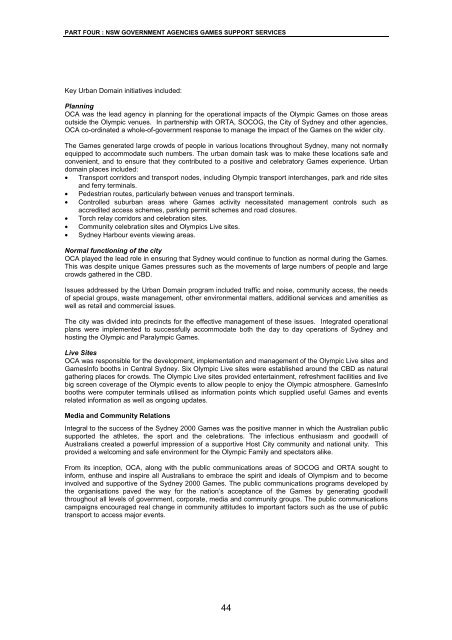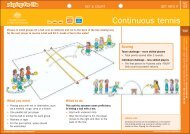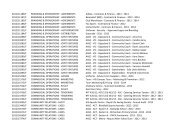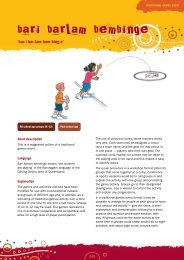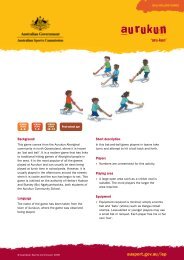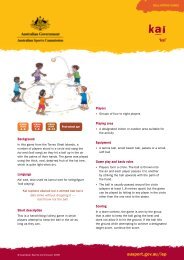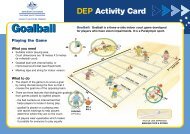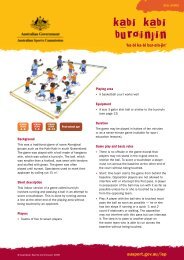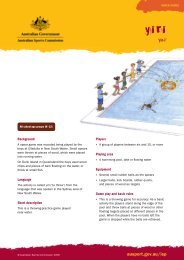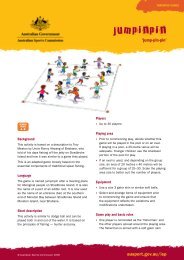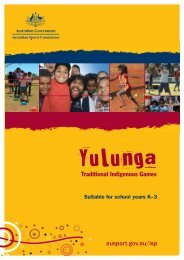the sydney 2000 olympic and paralympic games - Australian Sports ...
the sydney 2000 olympic and paralympic games - Australian Sports ...
the sydney 2000 olympic and paralympic games - Australian Sports ...
You also want an ePaper? Increase the reach of your titles
YUMPU automatically turns print PDFs into web optimized ePapers that Google loves.
PART FOUR : NSW GOVERNMENT AGENCIES GAMES SUPPORT SERVICES<br />
Key Urban Domain initiatives included:<br />
Planning<br />
OCA was <strong>the</strong> lead agency in planning for <strong>the</strong> operational impacts of <strong>the</strong> Olympic Games on those areas<br />
outside <strong>the</strong> Olympic venues. In partnership with ORTA, SOCOG, <strong>the</strong> City of Sydney <strong>and</strong> o<strong>the</strong>r agencies,<br />
OCA co-ordinated a whole-of-government response to manage <strong>the</strong> impact of <strong>the</strong> Games on <strong>the</strong> wider city.<br />
The Games generated large crowds of people in various locations throughout Sydney, many not normally<br />
equipped to accommodate such numbers. The urban domain task was to make <strong>the</strong>se locations safe <strong>and</strong><br />
convenient, <strong>and</strong> to ensure that <strong>the</strong>y contributed to a positive <strong>and</strong> celebratory Games experience. Urban<br />
domain places included:<br />
• Transport corridors <strong>and</strong> transport nodes, including Olympic transport interchanges, park <strong>and</strong> ride sites<br />
<strong>and</strong> ferry terminals.<br />
• Pedestrian routes, particularly between venues <strong>and</strong> transport terminals.<br />
• Controlled suburban areas where Games activity necessitated management controls such as<br />
accredited access schemes, parking permit schemes <strong>and</strong> road closures.<br />
• Torch relay corridors <strong>and</strong> celebration sites.<br />
• Community celebration sites <strong>and</strong> Olympics Live sites.<br />
• Sydney Harbour events viewing areas.<br />
Normal functioning of <strong>the</strong> city<br />
OCA played <strong>the</strong> lead role in ensuring that Sydney would continue to function as normal during <strong>the</strong> Games.<br />
This was despite unique Games pressures such as <strong>the</strong> movements of large numbers of people <strong>and</strong> large<br />
crowds ga<strong>the</strong>red in <strong>the</strong> CBD.<br />
Issues addressed by <strong>the</strong> Urban Domain program included traffic <strong>and</strong> noise, community access, <strong>the</strong> needs<br />
of special groups, waste management, o<strong>the</strong>r environmental matters, additional services <strong>and</strong> amenities as<br />
well as retail <strong>and</strong> commercial issues.<br />
The city was divided into precincts for <strong>the</strong> effective management of <strong>the</strong>se issues. Integrated operational<br />
plans were implemented to successfully accommodate both <strong>the</strong> day to day operations of Sydney <strong>and</strong><br />
hosting <strong>the</strong> Olympic <strong>and</strong> Paralympic Games.<br />
Live Sites<br />
OCA was responsible for <strong>the</strong> development, implementation <strong>and</strong> management of <strong>the</strong> Olympic Live sites <strong>and</strong><br />
GamesInfo booths in Central Sydney. Six Olympic Live sites were established around <strong>the</strong> CBD as natural<br />
ga<strong>the</strong>ring places for crowds. The Olympic Live sites provided entertainment, refreshment facilities <strong>and</strong> live<br />
big screen coverage of <strong>the</strong> Olympic events to allow people to enjoy <strong>the</strong> Olympic atmosphere. GamesInfo<br />
booths were computer terminals utilised as information points which supplied useful Games <strong>and</strong> events<br />
related information as well as ongoing updates.<br />
Media <strong>and</strong> Community Relations<br />
Integral to <strong>the</strong> success of <strong>the</strong> Sydney <strong>2000</strong> Games was <strong>the</strong> positive manner in which <strong>the</strong> <strong>Australian</strong> public<br />
supported <strong>the</strong> athletes, <strong>the</strong> sport <strong>and</strong> <strong>the</strong> celebrations. The infectious enthusiasm <strong>and</strong> goodwill of<br />
<strong>Australian</strong>s created a powerful impression of a supportive Host City community <strong>and</strong> national unity. This<br />
provided a welcoming <strong>and</strong> safe environment for <strong>the</strong> Olympic Family <strong>and</strong> spectators alike.<br />
From its inception, OCA, along with <strong>the</strong> public communications areas of SOCOG <strong>and</strong> ORTA sought to<br />
inform, enthuse <strong>and</strong> inspire all <strong>Australian</strong>s to embrace <strong>the</strong> spirit <strong>and</strong> ideals of Olympism <strong>and</strong> to become<br />
involved <strong>and</strong> supportive of <strong>the</strong> Sydney <strong>2000</strong> Games. The public communications programs developed by<br />
<strong>the</strong> organisations paved <strong>the</strong> way for <strong>the</strong> nation’s acceptance of <strong>the</strong> Games by generating goodwill<br />
throughout all levels of government, corporate, media <strong>and</strong> community groups. The public communications<br />
campaigns encouraged real change in community attitudes to important factors such as <strong>the</strong> use of public<br />
transport to access major events.<br />
44


